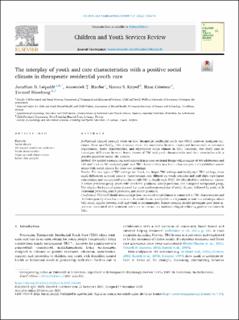| dc.contributor.author | Leipoldt, Jonathan David | |
| dc.contributor.author | Harder, Annemiek T. | |
| dc.contributor.author | Kayed, Nanna Sønnichsen | |
| dc.contributor.author | Grietens, Hans | |
| dc.contributor.author | Rimehaug, Tormod | |
| dc.date.accessioned | 2023-03-20T09:50:07Z | |
| dc.date.available | 2023-03-20T09:50:07Z | |
| dc.date.created | 2022-04-11T10:59:58Z | |
| dc.date.issued | 2022 | |
| dc.identifier.citation | Children and Youth Services Review. 2022, 134 . | en_US |
| dc.identifier.issn | 0190-7409 | |
| dc.identifier.uri | https://hdl.handle.net/11250/3059166 | |
| dc.description.abstract | Background Limited research exists on how therapeutic residential youth care (TRC) achieves treatment outcomes. More specifically, little is known about the association between contextual factors such as treatment organization, youth characteristics, and experienced social climate in TRC. Therefore, this study aims to investigate differences between latent classes of TRC and youth characteristics and their association with a positive perceived social TRC climate. Method We applied a person-centered approach in a cross-sectional design with a sample of 400 adolescents and 142 staff leaders. We analyzed youth and TRC characteristics in a latent class analysis and established associations with social climate for these two groupings. Results The two types of TRC settings we found, i.e., larger TRC settings and family-style TRC settings, show small differences in social climate. These settings only differed on youth activities and staff shifts type (more cohabitation and unorganized activities outside TRC in family-style TRC). We identified four adolescent classes: A severe problems group, youth with incidental problems, family problems, and a migrant background group. The migrant background group showed the most positive perceptions of social climate, followed by youth with incidental problems, family problems, and severe problems. Conclusions TRC staff should acknowledge how perceived social climate is connected to TRC characteristics and the heterogeneity of adolescents in care. As social climate is subjective and dynamic, a continuous dialogue about TRC social climate between staff and youth is recommended. Future research should investigate how these aspects are associated with treatment outcomes to increase our understanding of achieving positive outcomes in TRC. | en_US |
| dc.language.iso | eng | en_US |
| dc.publisher | Elsevier B. V. | en_US |
| dc.rights | Navngivelse 4.0 Internasjonal | * |
| dc.rights.uri | http://creativecommons.org/licenses/by/4.0/deed.no | * |
| dc.title | The interplay of youth and care characteristics with a positive social climate in therapeutic residential youth care | en_US |
| dc.title.alternative | The interplay of youth and care characteristics with a positive social climate in therapeutic residential youth care | en_US |
| dc.type | Peer reviewed | en_US |
| dc.type | Journal article | en_US |
| dc.description.version | publishedVersion | en_US |
| dc.source.pagenumber | 17 | en_US |
| dc.source.volume | 134 | en_US |
| dc.source.journal | Children and Youth Services Review | en_US |
| dc.identifier.doi | 10.1016/j.childyouth.2021.106348 | |
| dc.identifier.cristin | 2016662 | |
| dc.source.articlenumber | 106348 | en_US |
| cristin.ispublished | true | |
| cristin.fulltext | original | |
| cristin.qualitycode | 1 | |

